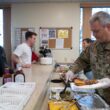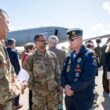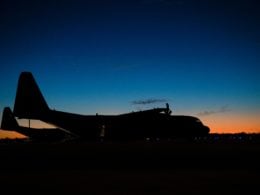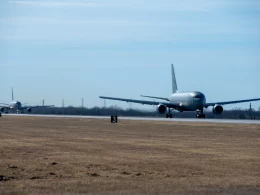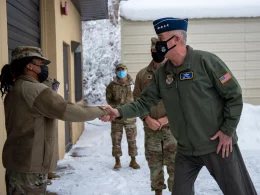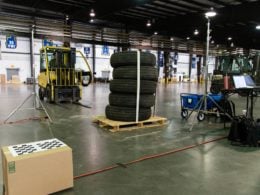ANDERSEN AIR FORCE BASE, Guam —
The 734th Air Mobility Squadron from Andersen Air Force Base, Guam, showcased how they are preparing to be the mobility hub for the second island chain during an immersion with Maj. Gen. John Klein, U.S. Air Force Expeditionary Center commander, and Chief Master Sgt. Courtney Freeman, USAFEC command chief.
As the USAFEC enterprise continues to emphasize the importance of the Global Air Mobility Support System, it is imperative that the Air Mobility Squadrons continue to evolve and become light, lean, and agile.
“If you look at the Pacific war plan from World War II you will see how they were able to island hop, creating mobility nodes stretching across the Pacific to be effective,” said Lt. Col. Jeremy Stuursma, 734th AMS commander. “We cannot have vast gaps of water without infrastructure. We are in the process to rebuild a system that was already there.”
The unit plans to fill those vast gaps of water using Air Mobility Teams. Since the idea was presented, the 734th AMS has been integrating and utilizing the 36th Contingency Response Group assets and training opportunities to ensure they maximize the capability for future conflicts.
“All the Pacific Air Forces exercises allowed us to get after higher level training that all of us in the unit have been craving,” Stuursma said. “We want to be a part of something important and every single one of the Airmen understand the importance of the mission here.”
The squadron initially started experimenting with a six-man team before trying several iterations that Air Mobility Command and other players developed. This approach established benchmark processes among the numerous exercises that take place in the second island chain.
“I’m so proud of our Airmen, they were able to take the problem set of agile combat employment and have been able to figure out all the little pieces to make it work,” Stuursma said. “It’s so awesome to watch them come up with innovative ways to get after the mission.”
Although AMTs are still a concept, they are now able to take a static air mobility squadron, which has a fixed set of personnel, and send them to different locations. This creates additional throughput capacity that did not exist originally, while maintaining that same capability from their home station.
“We want to make it operationally unpredictable for our adversaries,” said Col. Kyle Benwitz, 515th Air Mobility Operations Wing commander. “We can quickly take a static force disaggregate to multiple locations, creating options for our allies and partners to recover and relaunch, making any targeting solution difficult while creating additional throughput capacity for cargo and sustainment and as necessary reaggregate to project combat power.”
According to Benwitz, they are using this concept in multiple exercises, including Beverly High at Kadena Air Base, Japan, and Cope North at Andersen Air Force Base, Guam. Working alongside contingency response groups, they are able to not only open logistic hubs at remote locations, but also at austere locations based on the capability and requirements needed for the exercise.
“These exercises are a great example of our Airmen bringing a capability and delivering on it,” Klein said. “AMTs will be the future, and we will be ready for the pacing challenge.”





